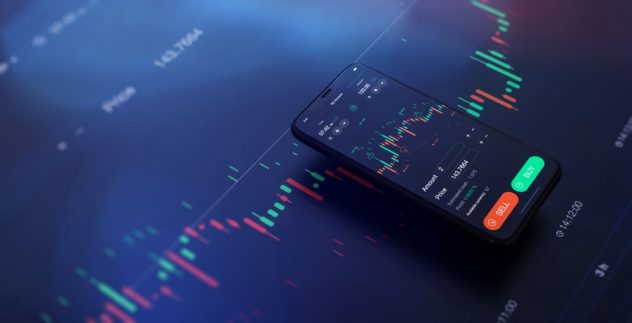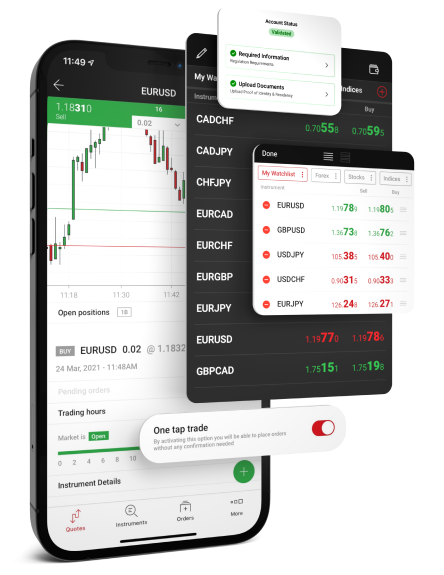-
Exchange rate regimen where a currency’s exchange rate is pegged (fixed) in relation to a stronger currency, such as the US Dollar or the Euro. The pegged rate is adjusted occasionally in an attempt to improve the country’s competitive position. For example, China’s Yuan is sometimes pegged to the US Dollar.
-
The total amount of exposure a bank or broker has with a client for in spot and forward foreign exchange contracts.
-
A fee charged to exchange money from one currency to another.
-
This is the simultaneous buying and selling of foreign exchange pairs in order to realize a profit from a discrepancy between foreign exchange rates in the market at the same time in different markets.
-
This is the price at which the foreign exchange pair or CFD is offered.
-
Depending on the regulatory body, a dealer authorised to deal in Foreign Exchange.
-
A trader who uses an automated system to input trades without any human input.
-
A settlement system used by banks and brokers to process and report transactions.
-
System of recording a country’s economic transactions.
-
A common type of charting method which consists of four significant points: the high and the low prices, which form the vertical bar, the opening price, which is marked with a horizontal line to the left of the bar, and the closing price, which is marked with a little horizontal line to the right of the bar.
-
In countries where the currency is pegged, the range in which the rates are permitted to fluctuate.
-
Paper issued by a Central Bank, redeemable as money and considered to be legal tender.
-
The rate at which a central bank is prepared to lend money to its domestic banking system.
-
Days of the week when commercial banks are open for business in the country of the particular currency traded.
-
A view taken by a trader going ‘short’ in the expectation of a decrease in the price of a currency.
-
An extended period of general price decline in an individual security, an asset, or a market.
-
The price at which a buyer is willing to buy in the market. The best bid is the highest bid price available.
-
Represents the difference between the buy (bid) and sell (ask) price of a foreign exchange pair.
-
An agent, who executes orders to buy and sell currencies and related instruments either for a commission or on a spread. Brokers are agents working on commission and not principals or agents acting on their own account. In the foreign exchange market brokers tend to act as intermediaries between banks bringing buyers and sellers together for a commission paid by the initiator or by both parties. There are four or five major global brokers operating through subsidiaries affiliates and partners in many countries.
-
A company that offers trading services to the public.
-
A view taken by a trader going ‘long’ in the expectation that the currency will appreciate.
-
A market that is on a consistent upward trend.
-
An order to execute a transaction at a specified price (the limit) or lower.
-
The process of buying a currency pair where a client pays cash for part of the overall value of the position. The word margin refers to the portion the investor puts up rather than the portion that is borrowed.
-
A term used in the foreign exchange market for the US Dollar/British Pound rate.
-
A type of chart which consist of four major prices: high, low, open, close. The body (jittai) of the candlestick bar is formed by the opening and closing prices. To indicate that the opening was lower than the closing, the body of the bar is left blank. If the currency closes below its opening, the body is filled. The rest of the range is marked by two “shadows”: the upper shadow (uwakage) and lower shadow (shitakage).
-
Foreign exchange rate quoted by a bank each day for small foreign exchange transactions.
-
The interest cost of financing securities or other financial instruments held.
-
Funds deposited in a trading account.
-
A Central Bank provides financial and banking services for a country’s Government and Commercial Banks. It implements the Government’s monetary policy, as well, by changing interest rates.
-
The money that a country uses. Currencies can be traded for other currencies on the foreign exchange market, so each currency has a value relative to another.
-
A buy or sell order that will expire automatically at the end of the trading day on which it is entered.
-
A trade opened and closed on the same trading day.
-
The primary method of recording the basic information relating to a transaction.
-
An individual or firm acting as a principal, rather than as an agent, in the purchase and/or sale of foreign exchange. Dealers trade on their own account and take on proprietary risk.
-
A downward change in the official parity of an exchange rate from the rate at which it was previously set. This term is inappropriate in the context of a floated currency i.e. the GBP.
-
This is the amount by which a foreign currency is cheaper to buy for future delivery rather than for spot delivery.
-
ECN stands for Electronic Communication Network.
-
A statistic that is used to gauge current economic conditions.
-
This is the expression used to describe the value of one currency in terms of another. For example, in the exchange rate AUD/USD 1.04502, one Australian dollar is equal to 1.04 United States cents.
-
The total amount of money loaned to a borrower or country. Banks set rules to prevent overexposure to any single borrower. In trading operations, it is the potential for running a profit or loss from fluctuations in market prices.
-
Foreign Currencies of countries that do not have a developed international market and are relatively illiquid.
-
Fiat currency is the opposite of a gold standard arrangement. In a fiat currency system, the currency value rises and falls on the market in response to demand and supply pressures. It is this fluctuation that makes it possible to speculate on future currency values.
-
Indicates that a Currency is strengthening or is stronger than previously quoted.
-
A transaction with a settlement date that is more than 2 business days after the actual trade date.
-
The basic economic determinants of exchange rates, such as inflation, interest rates, commodity prices and economic activity.
-
An obligation to exchange a good or instrument at a set price on a future date. The primary difference between a Future and a Forward is that Futures are typically traded over an exchange while forwards are traded over the counter (OTC).
-
The seven leading industrial countries: The United States, Germany, Japan, France, United Kingdom, Canada, and Italy.
-
An order instruction provided to a broker that does not expire at the end of the trading day, although normally terminates at the end of the trading month.
-
A series of positions and open orders that are built with a predetermined spread defined by the trader.
-
Total value of a country’s output, income or expenditure produced within the country’s physical borders.
-
A strategy used to offset market risk, whereby one position protects another.
-
Buyer and subsequently owner of a currency pair.
-
International Foreign Exchange Master Agreement
-
A trader who trades for small, short-term profits during the course of a trading session, rarely carrying a position overnight.
-
Traders term for the New Zealand Dollar.
-
The ratio of margin to the maximum position size. With a deposit of $1000 and a leverage of 100, a trader could enter a position with a face value of $100,000. Leveraging allows you to profit quickly, but lose money just as fast.
-
In terms of foreign exchange , the obligation to deliver to a counterparty an amount of currency either in respect of a balance sheet holding at a specified future date or in respect of an un-matured forward or spot transaction.
-
Excess of purchases over sales or of foreign currency assets over liabilities.
-
Dealer slang for the USA/CAD currency pair.
-
Standardised method of trading in Forex, which requires a trade of 100,000 units of a particular currency.
-
A demand for additional funds to be deposited in a margin account to meet margin requirements because of adverse future price movements.
-
A dealer is said to make a market when they quote bid and offer prices at which they are ready to deal on.
-
An order to buy or sell a financial instrument at the best possible price at the time the order is placed.
-
Difference between the buying and selling rates, also used to indicate the discount or premium between spot or forward.
-
Currency positions that have not been offset with opposite positions.
-
An investor who bases his/her decisions on the outcome of a news announcement and its impact on the market.
-
The price at which a seller is willing to sell. The best offer is the lowest such price available.
-
The difference between assets and liabilities in a particular currency. This may be measured on a per currency basis or the position of all currencies when calculated in base currency.
-
A market conducted directly between dealers and principals via a telephone and computer network rather than a regulated exchange trading floor.
-
Is the term applied when the forward price of the purchase or sale of a currency is the same as the spot price.
-
See point.
-
(1) 100th part of a per cent, normally 10,000 of any spot rate. Movement of exchange rates are usually in terms of points. i.e if AUD/USD moves from 1.0410 to 1.0420, it has moved 10 points / pips. (2) Minimum fluctuation or smallest increment of price movement.
-
The netted total commitments in a given currency. A position can be either flat or square ( no exposure), long, (more currency bought than sold), or short ( more currency sold than bought).
-
The actual “realized” gain or loss resulting from trading activities on Closed Positions, plus the theoretical “unrealized” gain or loss on Open Positions that have been Mark-to-Market.
-
An indicative price. The price quoted for information purposes but not to deal.
-
The second currency of two in a currency pair. For the EUR/USD, USD is the quote currency. The exchange rate quoted is how many units of the second currency you will receive for one unit of the base currency.
-
A recovery in price after a period of decline.
-
The difference between the highest and lowest price of a future recorded during a given trading session.
-
Excess of sales over purchases or of foreign currency liabilities over assets.
-
Foreign exchange bought and sold for delivery two business days after the deal is firmed.
-
The value difference between the bid and ask price of a currency pair.
-
An arrangement whereby a position is automatically closed out when it reaches a certain loss or when exchange rates reach specified values.
-
Trader’s nickname for the Swiss Franc.
-
A customer’s instructions to buy or sell a currency pair which, when executed, will result in the reduction in the size of the existing position and show a profit on said position.
-
A limit order that is placed above the market with a long position or below the market with a short position. When the market reaches the limit price, the position is closed thereby locking in a profit.
-
A widely used quantity of currency. In forex trading, one unit of USD is equal to one United States dollar, while one unit of EUR is one Euro. For JPY, one unit is equivalent to one Yen. One unit is the smallest trade size in Forex trading.
-
Your current potential account balance that can be realized by closing all your open trades. For example, if your actual account balance is $925 and you have an open trade for $50 with a $25 profit, your virtual account balance will show $1,000.
-
The number, or value, of securities traded during a specific period.
-
A day on which the banks in a currency’s principal financial centre are open for business. For FX transactions, a working day only occurs if the bank in both (all relevant currency centres in the case of a cross) are open.
-
A traders’ term for a billion as in a billion dollars.








 Negative balance protection
Negative balance protection
 A reliable and regulated broker
A reliable and regulated broker
 Quick Account Verification
Quick Account Verification


